
The Royal Navy (RN) is the naval warfare force of the United Kingdom, British Overseas Territories and Crown Dependencies, and a component of His Majesty's Naval Service. Although warships were used by English and Scottish kings from the early medieval period, the first major maritime engagements were fought in the Hundred Years' War against France. The modern Royal Navy traces its origins to the English Navy of the early 16th century; the oldest of the UK's armed services, it is consequently known as the Senior Service.
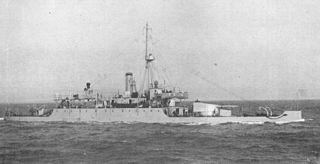
HMS Mersey was a Humber-class monitor of the Royal Navy. Originally built by Vickers for the Brazilian Navy and christened Madeira, she was purchased by the Royal Navy in 1914 on the outbreak of the First World War along with her sister ships Humber and Severn.

The River class was a class of 151 frigates launched between 1941 and 1944 for use as anti-submarine convoy escorts in the North Atlantic. The majority served with the Royal Navy and Royal Canadian Navy (RCN), with some serving in the other Allied navies: the Royal Australian Navy (RAN), the Free French Naval Forces, the Royal Netherlands Navy and, post-war, the South African Navy.
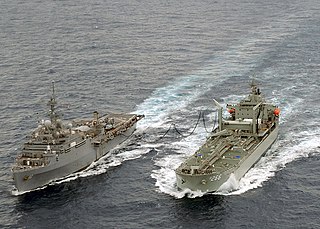
A replenishment oiler or replenishment tanker is a naval auxiliary ship with fuel tanks and dry cargo holds which can supply both fuel and dry stores during underway replenishment (UNREP) at sea. Many countries have used replenishment oilers.

Ships of the Royal Navy is a naval history reference work by J. J. Colledge (1908–1997); it provides brief entries on all recorded ships in commission in the Royal Navy from the 15th century, giving location of constructions, date of launch, tonnage, specification and fate.
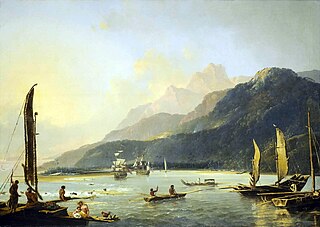
HMS Adventure was a barque that the Royal Navy purchased in 1771. She had been the merchant vessel Marquis of Rockingham, launched in 1770 at Whitby. In naval service she sailed with Resolution on James Cook's second expedition to the Pacific in 1772–1775. She was the first ship to circumnavigate the globe from west to east. After her return she served as a store ship until 1779. The navy sold her in 1783 and she resumed a civilian career, but retaining the name Adventure. She was lost in May 1811.

The Bangor-class minesweepers were a class of warships operated by the Royal Navy (RN), Royal Canadian Navy (RCN), Imperial Japanese Navy (IJN), and Royal Indian Navy (RIN) during the Second World War.
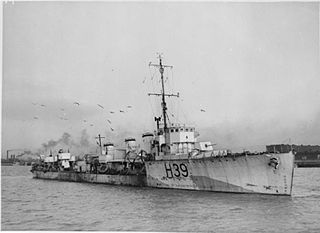
The first R class were a class of 62 destroyers built between 1916 and 1917 for the Royal Navy. They were an improvement, specifically in the area of fuel economy, of the earlier Admiralty M-class destroyers. The most important difference was that the Admiralty R class had two shafts and geared turbines, compared with the three shafts and direct turbines of the Admiralty M class, but in appearance the R class could be distinguished from its predecessors by having the after 4-inch gun mounted in a bandstand. The Admiralty ordered the first two of this class of ships in May 1915. Another seventeen were ordered in July 1915, a further eight in December 1915, and a final twenty-three in March 1916.

Adrias was a Type III Hunt-class destroyer that was originally built for the Royal Navy as HMS Border but never commissioned. Before her completion, she was loaned to the Royal Hellenic Navy on 20 July 1942 and commissioned as Adrias on 5 August 1942 in order to relieve heavy losses of ships sustained by the Royal Hellenic Navy during the German invasion of 1941 and throughout the war. Adrias took her name from the ancient Greek town of Adria in Italy, at the mouth of the Po river, after which the Adriatic Sea is named.
Sydney Knowles, BEM, was a British Royal Navy frogman during and after World War II.

HMS Coventry was a C-class light cruiser of the Royal Navy, named after the English city of Coventry. She was part of the Ceres group of the C-class of cruisers.
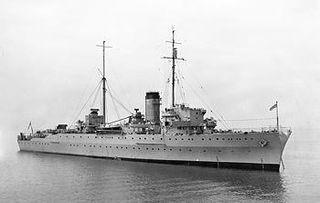
HMS Protector was an Antarctic patrol vessel of the Royal Navy between 1955 and 1968. She was built in 1935 as a net laying ship.

The action of 11 November 2008 was a naval engagement fought off Somalia between pirates and British forces. Russia has stated that its forces fought off the pirates also, though Russia's involvement has been disputed by the Royal Navy. The incident took place 60 nautical miles (110 km) south of the Yemeni coast, in the Gulf of Aden. When the Royal Navy ship HMS Cumberland, "attached to the NATO task force in the region" attempted to board a Somali pirate dhow with twelve pirates on board, the pirates initially resisted with assault rifle fire. After a brief shoot-out with the Royal Marines, two pirates were killed and the dhow was captured by Cumberland. The Times has described the incident as "the first time the Royal Navy had been engaged in a fatal shoot-out on the high seas in living memory." The Independent has also stated that the confrontation "is believed to be the first time recently that British naval service personnel have been involved in a confrontation that resulted in deaths", and The Toronto Star has stated that the engagement is "the first time since the 1982 Falklands War that the Royal Navy had killed anyone on the high seas."

HMS Untamed was a Royal Navy U-class submarine built by Vickers-Armstrongs, High Walker. So far, she has been the only ship of the Royal Navy to bear the name Untamed. On 30 May 1943, she sank during a training exercise in the Firth of Clyde with the loss of all 35 of her crew. Untamed was subsequently salvaged and renamed HMS Vitality, another unique name, and lasted until 1946 when she was scrapped.
HMS Mary Rose, launched on 8 October 1915, was an Admiralty M-class destroyer sunk on 17 October 1917 approximately 70 miles east of Lerwick in an action off Lerwick while escorting a convoy of 12 merchant ships from Norway. The wreck is designated as a protected place under the Protection of Military Remains Act 1986.

The eighth HMS Worcester, was a Modified W-class destroyer of the British Royal Navy that saw service in World War II. She later served as an accommodation ship as the second HMS Yeoman.

HMCS Thetford Mines was a River-class frigate that served with the Royal Canadian Navy during the Second World War. She served primarily as a convoy escort in the Battle of the Atlantic. She was named for Thetford Mines, Quebec.

HMS Nith was a River-class frigate of the Royal Navy during World War II. In 1948, she was transferred to the Egyptian Navy and given the name Domiat.















